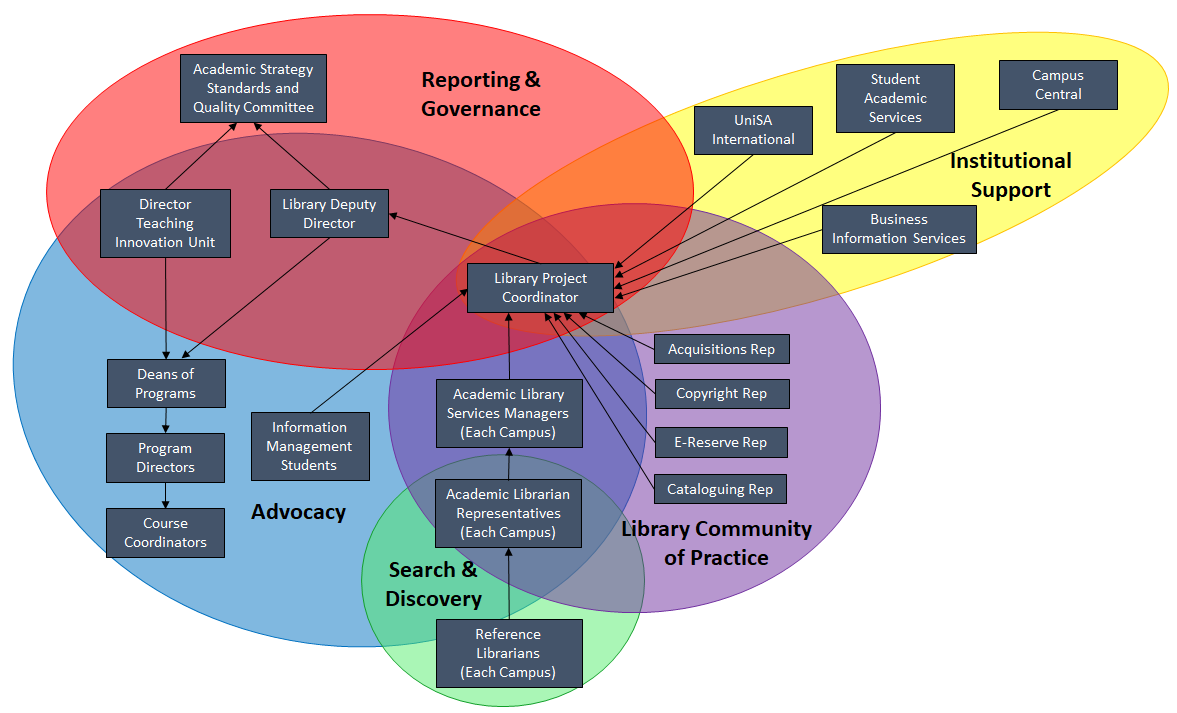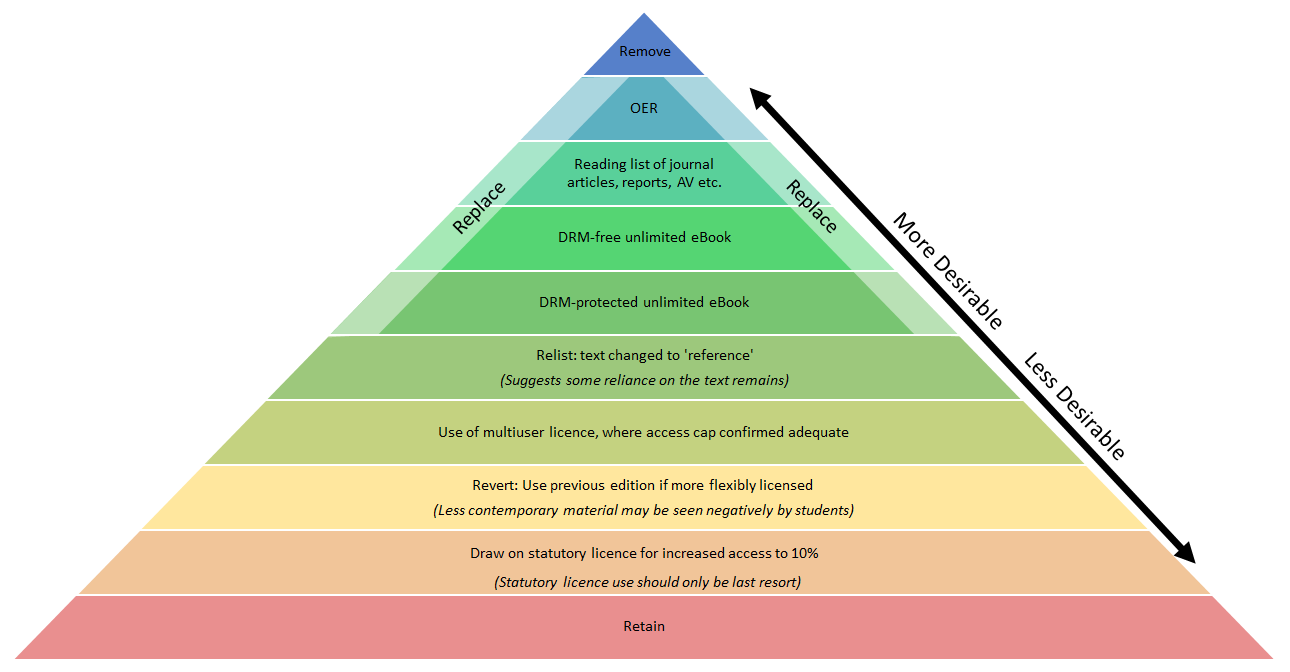Advocacy
Textbook Cost-To-Students Minimisation Pilot
University of South Australia
Ash Barber and Sarah McQuillen
Overview
This case study outlines the University of South Australia’s Textbook Minimisation Pilot, a two-year project which aimed to reduce the number of assigned textbooks only available for institutional purchase under a limited user license or in print only. This pilot allowed for adoption of formats other than OER, and so can be considered a ‘soft transition’ toward the adoption of OER. Thirteen courses adopted OER as a result of the pilot, saving the student body an estimated $9 million.
This case study provides a whole-of-University framework to facilitate and support academic staff to transition from traditional commercial textbooks, toward more flexible materials such as OER. The chapter includes a strong focus on awareness-raising and educational outreach activities undertaken by the Library to highlight barriers anticipated to be encountered by institutions undertaking resource transitions, and provides strategies and support networks to overcome these.
Using this case study
This case study is useful for teaching academics, learning designers and library staff. After reading this chapter:
- Academic staff will: Develop awareness of the perils of relying on commercial textbooks from financial, equity and accessibility perspectives; and understand the range of alternative resources available, including OER.
- Learning Designers will: Understand common barriers at a strategic level which can prevent academic staff from resourcing their courses as desired, and learn strategies through which these can be mitigated and to advocate for change.
- Library staff will: Learn strategies and techniques for building engagement across all stakeholders and gain an insight into a successful workflow with a view to leverage opportunities for promoting and adopting alternatives to commercial textbooks, including OER.
Why minimise textbooks?
UniSA prides itself on being a university of equity. With a large percentage of students from diverse socioeconomic backgrounds, combined with a significant online-only cohort, UniSA has long embraced a digital collection as a means to facilitate equitable access to course resources.
In recent years, Library efforts have been impeded by restrictive ebook licensing conditions imposed by commercial publishers, such as single to three user licenses with minimal download provision; prohibitive pricing; release of print-only formats to libraries; and bundling of eTextbook titles with additional content only made available to individual purchasers. Whilst academic staff often rely on textbooks to structure teaching and assessment, they are often unaware of the cost to students, or the limitations on Library access.
To understand the textbook financial burden on students, UniSA conducted a small-scale survey, which found 68% of students had chosen not to purchase a textbook at least once, with 48% relying on the Library copy. In addition, 41% said textbook purchases had impacted their ability to pay for rent, food, transport and other living costs, and 9% had unenrolled from a course to avoid these costs (view full survey results in this video). As one student described:
“The tutor told students that if we did not have the required textbook, we would not be able to pass the course. The textbook was super expensive and at the time I was dealing with significant financial hardship. This put me in a state of extreme academic stress that later flowed into other parts of my life, so I unenrolled.”
— Bachelor of Social Work student
To mitigate this financial burden on students, the UniSA Textbook Cost-To-Student Minimisation (aka ‘Textbook Minimisation’) pilot was born.
What is the Textbook Cost-To-Students Minimisation pilot?
Conducted during 2021 and 2022, the pilot was a joint initiative of UniSA Library and the UniSA Teaching Innovation Unit, a team of practised academics and specialists in learning design and technology. Academic Board endorsed the pilot, adding it to the University’s Academic Enterprise Plan 2021–2025 [pdf] (see Strategic Priority 2.7) and engaging Deans of Programs to drive participation.
A whole-of-library approach was employed in supporting the activities of the pilot. Under the leadership of a central Project Coordinator, a representative from each of the library discipline teams conducted engagement and communication activities and drew upon their teams’ support staff to conduct searching and resourcing activities.
Technical teams were also included in a monthly Library Staff Community of Practice group. This aimed to provide advice and library staff training and offer suggestions on untapped opportunities to improve existing workflows.
Throughout the pilot, the Library consulted with a range of stakeholders including the Teaching Innovation Unit, who assisted with advocacy at the strategic level, and with other administrative groups to source data and to update textbook-related documentation throughout the University.
Academic advocacy was crucial to raising awareness of the pilot and ebook licensing issues. Library staff presented at academic discipline Teaching and Learning Strategy Groups, and provided regular reports and updates. Similarly, the Coordinator engaged two project students enrolled in UniSA’s Library and Information Management program, who conducted a small-scale student survey on textbook purchasing behaviours and attitudes and created a promotional video.
A summary of pilot staff roles and stakeholders is presented in Figure 1 below.

In addition to reducing textbook costs and raising awareness, the Library aimed to develop sustainable textbook minimisation practices. The Library also set a target to remove or replace 50% of existing limited licence textbooks with more flexibly licensed alternatives including OER.
How did we do it?
The workflow comprised three phases:

As indicated in the workflow above, library staff began by confirming whether the usage of the text meets UniSA’s formal definition of a textbook: a resource that the student will require continual access to throughout the course. If usage did not meet this definition, it could simply be relisted as a reference text instead as this signals to UniSA students that continual access or purchase is not required.
When the assigned text did meet UniSA’s textbook definition, the Library liaised with academic staff to identify the information need being met by the text for which the Library would then strategically recommend alternatives.
A huge variety of options are available to remove or replace limited licence textbooks, so the Library found it challenging navigating this nuanced conversation with academic staff who are not familiar with licence restrictions or copyright allowances. The Library, therefore, created a hierarchy of resourcing options, prioritising flexible options such as OER, which was shared during discussions with academics. (See Figure 3, below.)

An emphasis of these conversations was the broad range of resourcing options available and the reassurance that academic staff held the ultimate decision as to whether the textbook was removed, replaced or even retained. As academic staff were empowered to opt out of the project at any stage, in some cases the workflow finished at this step with the academic indicating a solid rationale for retaining the text.
Outcomes: Where are we now?
The project saw a total of 47% reduction of limited licence textbooks across the entire two year pilot, just shy of the 50% target. Based on the Recommended Retail Price (RRP) of print textbooks, when the cost saved per course is multiplied by the number of student enrolments (14,096), the project achieved a total potential saving to UniSA students of approximately $9 million.
The success of the two-year pilot was such that we have now transitioned the project into business as usual, leveraging the new connections and workflows created to ensure textbook licensing considerations are a frequent topic whenever in contact with our academic teaching staff, with the knowledge that early identification of problematic texts is key.
The Textbook Minimisation pilot paved the way for OER activities at UniSA, with 13 courses adopting 12 OER as replacements for restrictively licensed commercial textbooks. Academics have been primed with two years of knowledge of the dire financial situation for students and now have experience and trust in the ways the Library can help to identify alternative resource options without adding pressure to change their course materials. Throughout the Textbook Minimisation pilot, the Library remained committed to upholding academic freedom, acting only as a knowledgeable information source, listening to the needs of academics and their students, and providing options, not demands. This commitment from the Library to consistently recognise the academic as the content expert and, therefore, the final decision-maker, has been integral to building trusting relationships with staff.
The project had a positive impact on all interested parties:
- Academic staff
- Have greater choice when selecting course readings and materials
- Discover more flexible ways they can teach with OER and suites of readings redefining the “textbook”
- Students
- Save on removed textbook costs
- Library studies students gained experience designing and conducting surveys, and knowledge of ebook licensing models and alternatives such as OER/CC
- Library
- Changed processes to leverage opportunities for textbook alternatives, organically capturing instances where textbooks with insufficient access may have been assigned
- Educated staff on OER and textbook licensing issues
- Empowered staff to conduct informed and impactful conversations with publishers about access models
- Teaching Innovation Unit
- Gained awareness of extensive Library services to support course resourcing
- Built knowledge of problematic ebook licensing and potential alternative options
- Reduced workload related to creation of in-house learning objects
- Embedded best practice in online course development by including relevant and accessible materials
Recommendations and pitfalls to navigate
Throughout the project, we identified a variety of barriers to textbook minimisation. These pitfalls and recommendations for mitigation may be useful for other institutions to consider when conducting similar activities.
Awareness and advocacy
It is evident that ongoing advocacy work with academic staff is still required to improve awareness of:
- The need (both financial and equitable) for textbook minimisation, and the benefits, from academic and student perspectives
- University operational distinctions between a textbook and a reference text
- Extensive support available from the Library
Timing and workload
The majority of restrictively licensed texts retained were due to timing and workload concerns, wherein some courses were not being actively taught, where academic workload precluded capacity to review or enact adoption of suggested materials, or where course coordinators were newly assigned and so did not feel confident to make changes.
This could be mitigated through changes to workflows, to seize early opportunities in course or program development, in refresh cycles, or during accreditation. At this early stage, academic staff have more time allocated to review options. Furthermore, as they then build the course around the suggested resources, the burden of disentangling an unsuitable textbook (and potential supplemental resources) is removed. Thus, these early intervention efforts are generally more successful than engaging with a course at a later stage of the cycle.
Publisher-supplied supplemental resources
Some courses had integrated publisher-supplied supplemental learning objects such as quizzes, case studies, animations and slides. As these learning objects are only made available to academic staff who set the associated textbook as the official course textbook, to remove or replace the listed textbook would require significant changes to the course site, where each learning object had been embedded, and to the weekly lesson plans designed around these objects.
Attachment to familiar texts
Some academic discipline cultures demonstrated strong attachment to familiar texts which had been used historically, or had a desire for students to build a professional library of textbooks. However, when Deans of Programs expressed their support and encouraged their academic staff to engage with the project, minimisation activities were more successful.
Niche publishing areas
Niche areas, such as Australian content and custom course editions posed a challenge for sourcing alternatives. Individual meetings with Course Coordinators were helpful in overcoming this challenge.
Failure to implement change
A few successfully targeted courses did not officially delist the textbook or have since listed new limited licence texts following a change of Course Coordinator. Reassuring academics that the project was not an attempt to encroach on their territory as subject and pedagogical experts helped to assuage a pervasive concern that all textbooks would be removed and without consultation. Maintaining a positive relationship with academic staff facilitated successful future conversations.
The Textbook Cost-to-Students Minimisation pilot has been challenging, but it has compelled us as a library to examine our digital practices and evolve to suit the changing textbook publishing landscape. Through these efforts, we hope to further alleviate the hidden, but often devastating, cost of textbooks for students.
Useful resources
- Check out the final report to the Academic Strategy, Standards and Quality Committee (ASSQC) [pdf] for full details of UniSA’s Textbook Cost-to-Students Minimisation pilot
Champion statements
“The textbook minimisation project is a great idea and approach to help reduce the cost of studying for students by reducing the number of textbooks that students need to buy. In place of textbooks, open access and other centrally licenced or free resources are provided to students to aid them with their studies. The library was very helpful in identifying suitable resources for a couple of more foundational physics courses, and we have now switched to using a free online textbook which the students really appreciate.”
— Dr Sam Tuttle, Lecturer: Applied Physics, Semester 2, 2021
“From the perspective of the editorial team of ‘Teach, Design, Thrive’, publishing our professional development resources as an OER is a wonderful opportunity to:
• Establish a one-stop-shop repository for organising and sharing curated resources produced in-house. As we are a large team of prolific content creators, this is a much-needed improvement in our practice.
• Share our resources with non-UniSA educators who may not have access to similar support (for example, people working in under-resourced institutions)
• Gain visibility for our work outside of UniSA and build a reputation among our peers as creators of high-quality content
• Experience the OER creation process first-hand, so that we can use this learning to support other UniSA educators wishing to publish their own resources
Importantly, we view open publishing as a way to enact all the UniSA core values, i.e.: Integrity and accountability; Diversity and social justice; Engagement and collaboration; Agility and innovation; Scholarship and excellence. The diversity and social justice elements is one we feel especially strongly about, not only in terms of providing access to published content at no cost to users, but also as OER publishing creates opportunities for under-represented groups and niche researchers to share their knowledge with the broader academic community, even when publication may not be commercially viable.
What we would like to see moving forward is greater recognition of the scholarly work involved in OER publishing, with institutions valuing OER creation as a demonstration of engagement in the Scholarship of Teaching and Learning and therefore equivalent to academic research publication. Without this recognition, allocating workload to OER creation can be challenging, especially when there are many competing priorities. Despite these challenges, we are thoroughly enjoying the creation process and look forward to publishing our OER and sharing it with the tertiary educators’ community.”
— Antonella Strambi, Lecturer: Academic Development Teaching Innovation Unit
In practice
Reflect on this case study by considering the following questions in relation to your own practice:
- Is your textbook access equitable and sufficient for your students?
- Are you aware of the range of alternative resources available, including OER which you could adopt instead? And do you know how to find these?
- How could your library support you in improving textbook access for your students?
- What are the strategic barriers that need to be addressed at your institution to encourage OER adoption or to implement an OER program?
Image descriptions
Figure 1: Pilot stakeholders and participants
Bubble chart of the five stakeholder groups and their reporting relationships involved in the project, with the Library Project Coordinator at the centre. The stakeholder groups overlap, with some staff therefore appearing within two or more groupings. The stakeholder groups and their staff are:
- Reporting and Governance: Academic Strategy Standards and Quality Committee, Director Teaching Innovation Unit, Library Deputy Director, and Library Project Coordinator
- Institutional Support: UniSA International, Student Academic Services, Campus Central, Business Information Services, and Library Project Coordinator
- Library Community of Practice: Acquisitions Representative, Copyright Representative, eReserve Representative, Cataloguing Representative, Academic Library Services Managers (each campus), Academic Librarian Representatives (each campus), and Library Project Coordinator
- Search and Discovery: Academic Librarian Representatives (each campus), and Reference Librarians (each campus)
- Advocacy: Library Deputy Director, Director Teaching Innovation Unit, Deans of Programs, Program Directors, Course Coordinators, Information Management Students, Academic Library Services Managers (each campus), Academic Librarian Representatives (each campus), and Library Project Coordinator
Groups 2, 3 and 4, and the Information Management Students in group 5, ultimately report to the Library Project Coordinator. The Library Project Coordinator then reports to the Library Deputy Director in group 1, who ultimately reports to the Academic Strategy Standards and Quality Committee. The Library and Teaching Innovation Unit Directors liaise directly with the Deans of Programs in group 5.
Figure 2: Textbook minimisation workflow
A three-phase workflow diagram with the following phases and their subordinate parts:
- Targeting
- Program Deans nominate program or course targets
- Library confirms associated texts are in scope of project: restrictive licences or print only; meet UniSA’s formal textbook definition
- Resourcing
- Library liaises with academic to identify the information need
- Library sources flexibly licensed alternatives, including OER
- Adoption
- Academic reviews alternatives for suitability
- Academic either: updates text in Course Management System; requests additional searching (Phase 2); or retains original text
- Project Coordinator reports outcomes
Figure 3: Hierarchy of textbook alternative resource options used in the project
A pyramid chart with ten levels of hierarchy and a double-ended arrow along the right hand side indicating resourcing options lower down the pyramid are less desirable (as they are more restrictive) and the resourcing options higher up the pyramid are more desirable (as they are less restrictive).
The levels of hierarchy from top (most desirable) to bottom (least desirable) are as follows:
- Remove
- OER
- Reading list of journal articles, reports, AV etc.
- DRM-free unlimited eBook
- DRM-protected unlimited eBook
- Relist: text changed to ‘reference’ (Suggests some reliance on the text remains)
- Use of multiuser licence, where access cap confirmed adequate
- Revert: Use previous edition if more flexibly licensed (Less contemporary material may be seen negatively by students)
- Draw on statutory licence for increased access to 10% (Statutory licence use should only be last resort)
- Retain
Levels two, three, four, and five are labelled as options where the textbook is replaced.
Acknowledgement of peer reviewers
The authors gratefully acknowledge the following people who kindly lent their time and expertise to provide peer review of this chapter:
- Jennifer Hurley, Lead, Open Publishing Team, RMIT University
- Mais Fatayer, Manager, Learning Experience Design, University of Technology Sydney
- Rani McLennan, Coordinator, Operations and Engagement, Council of Australasian University Libraries (CAUL)
How to cite and attribute this chapter
How to cite this chapter (referencing)
Barber, A., & McQuillen, S. (2024). Textbook Cost-To-Students Minimisation Pilot. In Open Education Down UndOER: Australasian Case Studies. Council of Australian University Librarians. https://oercollective.caul.edu.au/openedaustralasia/chapter/textbook-cost-to-students/
How to attribute this chapter (reusing or adapting)
If you plan on reproducing (copying) this chapter without changes, please use the following attribution statement:
Textbook Cost-To-Students Minimisation Pilot by Ash Barber and Sarah McQuillen is licensed under a Creative Commons Attribution 4.0 International licence.
If you plan on adapting this chapter, please use the following attribution statement:
*Title of your adaptation* is adapted from Textbook Cost-To-Students Minimisation Pilot by Ash Barber and Sarah McQuillen, used under a Creative Commons Attribution 4.0 International licence.
About the authors

name: Ash Barber
institution: University of South Australia
Ash Barber is an Academic Librarian at the University of South Australia. She is a Co-Convenor of the ASCILITE Australasian Open Educational Practice Special Interest Group (OEP SIG), a CAUL OER Collective Champion, and on the Open Education Conference Board of Directors. Check out her website EmpoweredOER which provides practical tools for embedding equity in OER. You can find Ash on LinkedIn, Mastodon.au and Bluesky @AshTheLibrarian.

name: Sarah McQuillen
institution: University of South Australia
Sarah McQuillen is an Academic Librarian at the University of South Australia. Sarah is a passionate educator with particular interest in the transformative power of knowledge and information literacy; most especially in online adult education.

